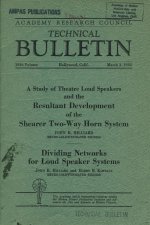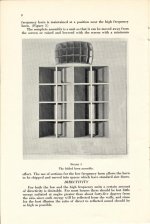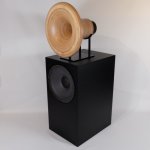Correct in that compression drivers are under-damped by design since the horn [WG not so much] is an intrinsically over-damped device, so historically only critically damped if a full expo, but if you [can] tune the rear chamber to the horn's mean you can near enough balance out other types to a greater or lesser extent [to my ears anyway].
Hmm, in retrospect, 'critically' damped in horn speak = reactance annulled, which can only be done with a full hyperbolic flare IIRC.
How can we determine ideal damping factor for a specific horn?
Never given it any thought, nor can I recall ever seeing anything written WRT it unless with higher math that my eyes always glaze over, so just guessing it would be calculated from the horn's tuning I mentioned same as a sealed cab's, though again, AFAIK we can only get close.
Anyway, I was taught to tune the rear chamber the mean between the HF, LF, so if designed for ~ 40 - 483 Hz, then [40*483]^0.5 = 139 Hz Fc which calculates a ~ 6.7424 Qtc that the horn shifts way down in peak, frequency to ~ 46 Hz and whatever its Qtc calculates to I guess in theory should be around/at 0.5, but HR sims > 32 dB/octave, so no clue what I'm missing, just know why they're technically so over damped, yet near enough a 'critically' damped reproducer and why my preferred cab alignment. 😉
Attachments
GM you always know what to say....
annul verb
an·nul | \ ə-ˈnəl \
annulled; annulling
Definition of annul
transitive verb
2 : to reduce to nothing : OBLITERATE
So from that, maybe we go into HornResp and view Reactance within the passband. Sounds good on paper. I can't look at hornresp without getting out of bed and going downstairs (mac-os)...but IIRC, reactance lives around the tuning note for vented designs. So that would suggest that it is a matter of placing the resonate note outside of the passband...Reminds me of my thread where I suggested that the way to tune a BP/TL for sound quality was no different from the approach for horns ie, placing tuning at half the lowest the intended note.
The proper way to tune a vented design for SQ.
Also, reverse engineering, model the response of the driver (not driver plus vent) to mimic that of a critically damped sealed box. Sounds good on paper, not sure if it holds water.
Obviously things are more complicated for a 6th order bandpass (I was kinda leaning towards critical damping for 4th order) but maybe some of the ideas above can apply there too. In particular the last idea of using horn resp to expose what the driver is doing vs driver+vent.
annul verb
an·nul | \ ə-ˈnəl \
annulled; annulling
Definition of annul
transitive verb
2 : to reduce to nothing : OBLITERATE
So from that, maybe we go into HornResp and view Reactance within the passband. Sounds good on paper. I can't look at hornresp without getting out of bed and going downstairs (mac-os)...but IIRC, reactance lives around the tuning note for vented designs. So that would suggest that it is a matter of placing the resonate note outside of the passband...Reminds me of my thread where I suggested that the way to tune a BP/TL for sound quality was no different from the approach for horns ie, placing tuning at half the lowest the intended note.
The proper way to tune a vented design for SQ.
Also, reverse engineering, model the response of the driver (not driver plus vent) to mimic that of a critically damped sealed box. Sounds good on paper, not sure if it holds water.
Obviously things are more complicated for a 6th order bandpass (I was kinda leaning towards critical damping for 4th order) but maybe some of the ideas above can apply there too. In particular the last idea of using horn resp to expose what the driver is doing vs driver+vent.
Last edited:
Hmm, didn't know this info was available and even after finding it, no clue what it's telling me beyond the fact that the two cross almost at the horn's Fh, so guessing this is the 'close, but no cigar' complete reactance annul or just due to math rounding off error.
??? No vent other than the big horn one. 😉 The compression driver is a traditional 4th order BP.
??? No vent other than the big horn one. 😉 The compression driver is a traditional 4th order BP.
Yeah I goofed on the order thing lol! 4th order vent and 4th order bandpass are the two I was talking about....
Ok...for 4th order vent...if viewing driver only, output, in hornresp,, is that of a critically damped closed box of the same volume...would it not suggest similar system compliance?
Regarding hornresp view pf reactance and resistance... now im not sure if its looking at the vent, the driver or both.
Ok...for 4th order vent...if viewing driver only, output, in hornresp,, is that of a critically damped closed box of the same volume...would it not suggest similar system compliance?
Regarding hornresp view pf reactance and resistance... now im not sure if its looking at the vent, the driver or both.
Last edited:
Oops! I was looking at a 45 Hz tuned BR's acoustic impedance originally, so apparently its high XO is somehow tied to pipe tuning [Fb].
The horn's butt up against each other at ~49 Hz, which makes a lot more sense to me re 'close, but no cigar' complete reactance annul, especially if referenced to the ~ 45 Hz initial impedance peak.
The horn's butt up against each other at ~49 Hz, which makes a lot more sense to me re 'close, but no cigar' complete reactance annul, especially if referenced to the ~ 45 Hz initial impedance peak.
Dr Geddes said in an other thread that there isn't much in "reactance nulling" - #7076/7 Acoustic Horn Design – The Easy Way (Ath4)
I still think there is something there - maybe the trials referenced was with an older design where it didn't matter / was burried. With the advancement of horns/WGs there might be a case if the ultimate is targeted.
//
I still think there is something there - maybe the trials referenced was with an older design where it didn't matter / was burried. With the advancement of horns/WGs there might be a case if the ultimate is targeted.
//
In reality Q is the product of many parameters, like leakage, stuffing, port damping, factual driver parameters etc.
Here are some comments.
Regarding 2 ways, excursion defines tuning. Opinions vary, but I prefer low Mms and limited Xmax woofers with a stiff and curved diaphragm > low losses and high efficiency are key here.
Straight-sided, thick/heavy diaphragms are better suited for sub duties, but can be used up to 400-500 Hz. Higher up they tend to sound muffled.
The actual Q - that results from a simulation, may vary between roughly 0.5 and 0.8, depending on the driver, cabinet etc.
Here are some comments.
Regarding 2 ways, excursion defines tuning. Opinions vary, but I prefer low Mms and limited Xmax woofers with a stiff and curved diaphragm > low losses and high efficiency are key here.
Straight-sided, thick/heavy diaphragms are better suited for sub duties, but can be used up to 400-500 Hz. Higher up they tend to sound muffled.
The actual Q - that results from a simulation, may vary between roughly 0.5 and 0.8, depending on the driver, cabinet etc.
Last edited:
Dr Geddes said in an other thread that there isn't much in "reactance nulling"
I still think there is something there -
Not surprised in that the tuning I posted predates any popular AES paper I'm aware of by at least a half century and the long and short of it is that as you deviate, the horn's LF rolls off at a slower order, so for me it just means a horn's equivalent of a 'critically' damped alignment with the hyperbolic the pinnacle/as good as it gets.
As for other horn types/alignments, the early bass horns are open back drivers, i.e. technically BLHs that are choked down pretty good by the horn based on the two I was exposed to early on.
Shearer horn:

Regarding 2 ways, excursion defines tuning. Opinions vary, but I prefer low Mms and limited Xmax woofers with a stiff and curved diaphragm > low losses and high efficiency are key here.
Straight-sided, thick/heavy diaphragms are better suited for sub duties, but can be used up to 400-500 Hz. Higher up they tend to sound muffled.
'Preaching to the choir'! 😉
Not a sub duty driver comparison, but gives a pretty good hint. 😉
Altec curvilinear [deep cone] Vs JBL [shallow cone] profiles [page 5]:
Attachments
Dr Geddes said in an other thread that there isn't much in "reactance nulling" - #7076/7 Acoustic Horn Design – The Easy Way (Ath4)
I still think there is something there - maybe the trials referenced was with an older design where it didn't matter / was burried. With the advancement of horns/WGs there might be a case if the ultimate is targeted.
//
Let's put it this way. It's just a part of a good horn design. The volume of the front chamber has many effects, manly at HFs, hence it may want to be something other than what is said to be ideal in that concept. It's just not that simple.
As for other horn types/alignments, the early bass horns are open back drivers, i.e. technically BLHs that are choked down pretty good by the horn based on the two I was exposed to early on.
Shearer horn
Especially for GM (and everybody interested in this milestone in loudspeaker history).
Technical Bulletin of the Academy Research Council, Volume 1936 March 3, The Shearer Two-Way Horn System.
Attachments
Last edited:
Thanks!  I actually read it in the mid '60s when I was exposed to it and an earlier RCA and had completely forgotten about it or would have searched the net long ago; glad it still exists!
I actually read it in the mid '60s when I was exposed to it and an earlier RCA and had completely forgotten about it or would have searched the net long ago; glad it still exists!
 I actually read it in the mid '60s when I was exposed to it and an earlier RCA and had completely forgotten about it or would have searched the net long ago; glad it still exists!
I actually read it in the mid '60s when I was exposed to it and an earlier RCA and had completely forgotten about it or would have searched the net long ago; glad it still exists!Regarding 2 ways, excursion defines tuning. Opinions vary, but I prefer low Mms and limited Xmax woofers with a stiff and curved diaphragm....
When you say limited Xmax....say for a 15"...how limited are we talking? 2mm? It would seem that driver compliance would be more important. Say you have 2 drivers, same diameter...matching qts...everything else the same but one has 2mm xmax, the other 10mm....where does the sonic difference occur in the shorter xmax favor?
When you say Q as in compliance is towards being "hypothetical"...I think you are hinting at the idea that compliance isnt a static figure, changing with frequency.
Last edited:
I think thats quite hypothetical. Low xmax is quite often relsted to voice coil architecture and Le, so thiele small parameters will be different.
Just for comparisons sake I guess...or maybe its the shift in thiele specs that cause his bias towards low xmax...not sure.
When you say limited Xmax....say for a 15"...how limited are we talking? 2mm? It would seem that driver compliance would be more important. Say you have 2 drivers, same diameter...matching qts...everything else the same but one has 2mm xmax, the other 10mm....where does the sonic difference occur in the shorter xmax favor?
When you say Q as in compliance is towards being "hypothetical"...I think you are hinting at the idea that compliance isnt a static figure, changing with frequency.
Ad 1.
Indeed, compliance is important.
All the (best) mid woofers I know (capable of playing > 500 Hz) have curved (light) diaphragms and limited Xmax.
Qts of appropriate midwoofers varies between roughly 0.30 and 0.35 and Cms between 0.15 and 0.25 mm/N.
The sonic difference depends on more parameters than just Xmax.
The composition of the paper pulp and even the coating can make a difference.
Ad 2.
Yes.
You can simulate a cabinet in Comsol with as many parameters as you want, but in the end the driver remains the bottleneck.
In the attached paper the B&W 800D is used as an example.
A couple of months ago, I referred to an Asian guy who has shown that the bass drivers from that same B&W 800D are still light years away from even the old Altecs. A key feature is, again, (lack of) efficiency.
Mind you, all this applies to mid woofers. Absolute low freq. extension is compromised here.
Attachments
Last edited:
Let's put it this way. It's just a part of a good horn design. The volume of the front chamber has many effects, manly at HFs, hence it may want to be something other than what is said to be ideal in that concept. It's just not that simple.
I would think it need to be a quite crappy horn in one sense as it shall be the "opposite" of a crappy driver 😉 maybe this is why it hasn't been done properly.
If one would aim for zero distorsion, it's probably the only way. Is it easy - no. But one brave soul will try one day, because that soul wants to push the frontiers, and if that soul succeed, it will be fantastic.
//
A 2 way system from the same manufacturer as the MTM, that was posted a few pages earlier.
There are few specifications available for this system, but I assume (given the horn) that the crossover is below 1000 Hz, presumably close to 500 Hz.
The JBL 2426J - including a Radian Alu diaphragm, was tested by another Frenchman:
The notion of value for money is irrelevant here. It is the most expensive of the group (by far!) But its performance is rather average. As with the DE250, provided the model tested is at its best, for me it is an outdated compression that is history.
500 Euro is a ridiculous amount for this driver.
There are few specifications available for this system, but I assume (given the horn) that the crossover is below 1000 Hz, presumably close to 500 Hz.
The JBL 2426J - including a Radian Alu diaphragm, was tested by another Frenchman:
The notion of value for money is irrelevant here. It is the most expensive of the group (by far!) But its performance is rather average. As with the DE250, provided the model tested is at its best, for me it is an outdated compression that is history.
500 Euro is a ridiculous amount for this driver.
Attachments
Last edited:
- Home
- Loudspeakers
- Multi-Way
- Is it possible to cover the whole spectrum, high SPL, low distortion with a 2-way?



